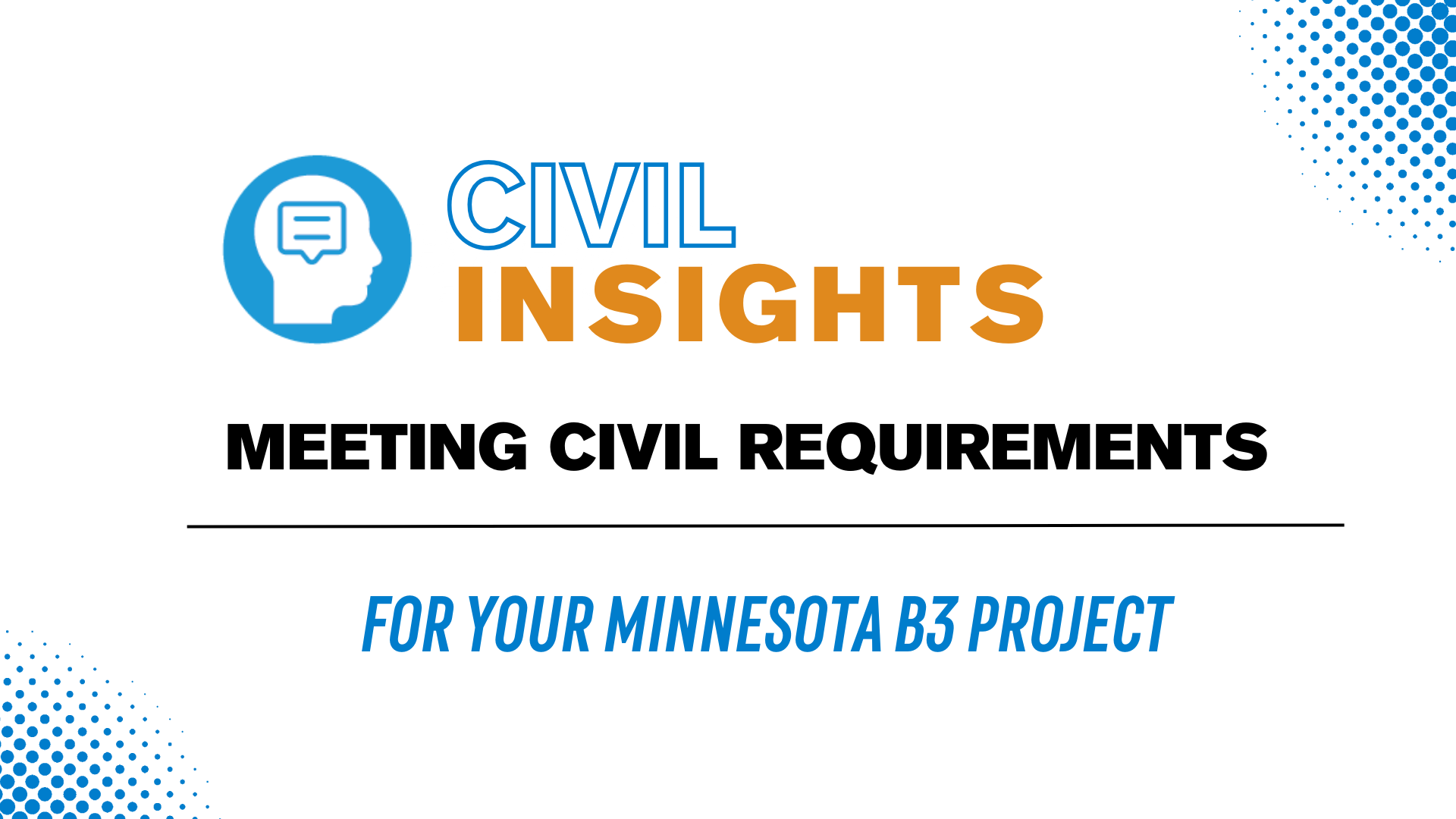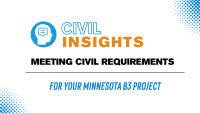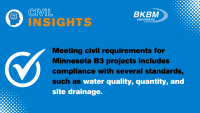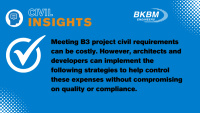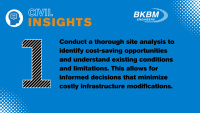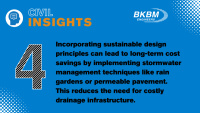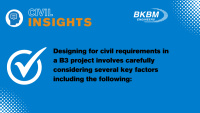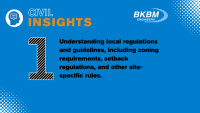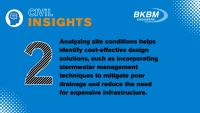Design with Sustainability in Mind, Ensure Compliance, and Achieve Success.
BKBM's expertise in navigating the Minnesota B3 process extends beyond the top-of-mind structural and mechanical sustainable design considerations. BKBM understands our civil engineering group's critical role in meeting site B3 requirements, including stormwater management, erosion control, and earthwork design. Prioritizing B3 early in the design process can save time, money, and resources in the long run.
We are here to help our development and design partners navigate these regulations efficiently and confirm that your project meets the Minnesota B3 civil requirements.
Understanding the Importance of Meeting Civil Requirements in Your B3 Project
Meeting civil requirements for B3 projects includes compliance with several standards, such as water quality, quantity, and site drainage. To meet these standards, BKBM's Civil Project Managers, Keith Matte and Joel Maier bring extensive knowledge of technology evaluations to the design team. They evaluate the site and space needs for B3 requirements and offer alternative solutions to overcome challenges and constraints in the final design. With their expertise, the team can efficiently navigate the regulatory process, minimize costs, and ensure compliance with civil requirements to achieve a successful and sustainable development.
Meeting civil requirements is essential in showing compliance with the MN B3 standards and contributes to your project's success. By carefully considering these requirements, you can create a more sustainable and resilient development that benefits both the environment and the community. From reducing water runoff to improving accessibility and safety, meeting civil requirements can have a lasting impact.
Navigating the Approval Process for MN B3 Certification
The regulatory process for meeting civil requirements in a B3 project can be complex and time-consuming, but ensuring compliance with the MN B3 standards is critical. This process involves navigating various regulatory agencies and obtaining the necessary permits and approvals.
One key aspect of the regulatory process is understanding the specific requirements and guidelines set forth by local authorities and how this will affect the B3 process. This may include submitting more detailed plans and stormwater calculations typically needed for local authorities and addressing any concerns or objections from stakeholders.
Engaging early with jurisdictional officials to understand the regulatory process and establish a collaborative working relationship is essential. They can provide valuable insights and guidance throughout the process, helping to streamline approvals and supporting compliance with all necessary B3 regulations. In addition, these agencies can assist the design team if any variances are needed in the B3 process.
Additionally, staying informed about any changes or updates to B3 regulations is essential to avoid potential setbacks or delays. By actively visiting and engaging in the regulatory process, architects, engineers, and developers can navigate these requirements more efficiently and achieve their desired B3 outcome.
Sometimes, B3 requirements may not be achievable due to site limitations such as site size/location or poor soil conditions, such as clayey soils or existing contamination. However, BKBM has successfully obtained variances in such situations.
Cost Control Strategies for Meeting Civil Requirements
Meeting the civil requirements for a B3 project can often come with significant costs. However, there are strategies that architects and developers can implement to help control these expenses without compromising on quality or compliance.
First, conducting a thorough site analysis can identify potential cost-saving opportunities. By understanding the site's existing conditions and limitations, architects and developers can make informed decisions that minimize the need for costly infrastructure modifications.
Second, early collaboration with civil engineers and regulatory officials is essential. Engaging them in the design process can lead to valuable input and innovative ideas for cost-effective solutions. Their expertise can help identify alternative materials or construction methods that meet the requirements while keeping expenses in check.
Additionally, incorporating sustainable design principles can lead to long-term cost savings. Implementing stormwater management techniques, such as rain gardens or permeable pavement, can reduce the need for costly drainage infrastructure.
Finally, maintaining open lines of communication with contractors and suppliers throughout the construction process can help identify potential cost overruns and find ways to address them proactively.
By implementing these cost control strategies, architects and developers can meet the civil requirements for their B3 project while staying within budget and achieving their desired outcome.
Key Considerations When Designing for Civil Requirements
Designing for civil requirements in a B3 project involves carefully considering several key factors. First and foremost, understanding the specific regulations and guidelines set forth by local authorities is crucial. This includes having a solid understanding of the zoning requirements, setback regulations, and any other site-specific rules that need to be followed. It's essential to work closely with civil engineers and city officials to meet compliance with these regulations and obtain the necessary permits and approvals.
Another important consideration is the site's existing conditions and limitations. Conducting a thorough site analysis will help identify potential challenges or opportunities for cost-effective design solutions. For example, if the site has poor drainage, incorporating stormwater management techniques like rain gardens or permeable pavement can help mitigate this issue and reduce the need for expensive drainage infrastructure.
Additionally, considering the long-term sustainability and resilience of the project is crucial.
Lastly, engaging with stakeholders and considering the community's needs is essential. Understanding the project's impact on accessibility, safety, and community connectivity is key to designing a successful and well-integrated development.
By considering these key considerations, architects and developers can design a B3 project that meets the necessary civil requirements and creates a sustainable, resilient, and community-centric development.
Words of Advice from Our Civil Experts When Designing for B3
One key consideration when meeting civil requirements is providing ample space for stormwater management. This is often overlooked, but it plays a vital role in reducing water runoff and mitigating the risk of flooding. In B3 projects, the stormwater can be more significant, requiring up to 30% of the site for stormwater management compared to the typical 15-20% for a regular site.
Additionally, if your site has sandy soils, confirming that it can effectively infiltrate the 25-year storm event is essential. This requires careful planning and design to accommodate the water infiltration needs.
By understanding these specific requirements and working with experts like BKBM, you can navigate the approval process, control costs, and design with these requirements in mind. Meeting the civil needs of your B3 project will comply with the MN B3 standards and contribute to your development's overall success and sustainability.
Case Studies: Success Stories in Meeting B3 Civil Requirements
When it comes to meeting the civil requirements for a B3 project, success stories are worth sharing. BKBM is no stranger to working through the MN B3 process. These case studies provide real-life examples of how architects and developers have effectively met the MN B3 standards and achieved their desired outcomes.
In one case study, a development team worked closely with BKBM’s civil engineers to implement innovative stormwater management techniques. At the Wakan Tipi Center, a project currently in design, BKBKM worked with the environmental engineer, the Minnesota Pollution Control Agency, B3 reviewers, and the Capitol Region Watershed District to provide a solution for stormwater management. At the same time, this solution did not meet the complete B3 requirements due to existing soil contamination. BKBM was able to design a system that maximized site infiltration while respecting the site constraints. We successfully applied for a variance that allowed the project to achieve B3 goals for the current stage of the project.
Another success story involves collaborating with architects, developers, and city officials. By maintaining open lines of communication throughout the regulatory process, the team could quickly address any concerns or objections from stakeholders. This proactive approach streamlined the approval process and ensured compliance with all necessary regulations.
These case studies highlight the importance of collaboration, innovation, and proactive engagement in meeting civil requirements for B3 projects. By learning from these success stories, architects and developers can gain valuable insights and strategies to achieve their B3 goals.
Additional B3 projects our team has successfully delivered include:
- Intensive Residential Treatment Services, Savage, MN
- West Side Flats Master Plan, St. Paul, MN
- The Parkway Apartments, St. Paul, MN
- KSMQ Public Television Station, Austin, MN
- MnSCU Dining Service Building, Mankato, MN
- Oliver Kelley Farm Visitor Center, Elk River, MN
- Three Rivers Park District Eastman Nature Center, Osseo, MN
- Crystal Police Station Renovation, Crystal, MN
Let's Make a B3 Design Partnership Happen
Are you struggling with the civil scope of your B3 project? Our experienced team at BKBM can help! We'll work closely with you to develop a comprehensive plan that meets your specific needs and supports the successful completion of your project. With years of experience and a commitment to quality, we're your trusted partner every step of the way. Let's get started! Contact Keith or Joel with your project needs.


